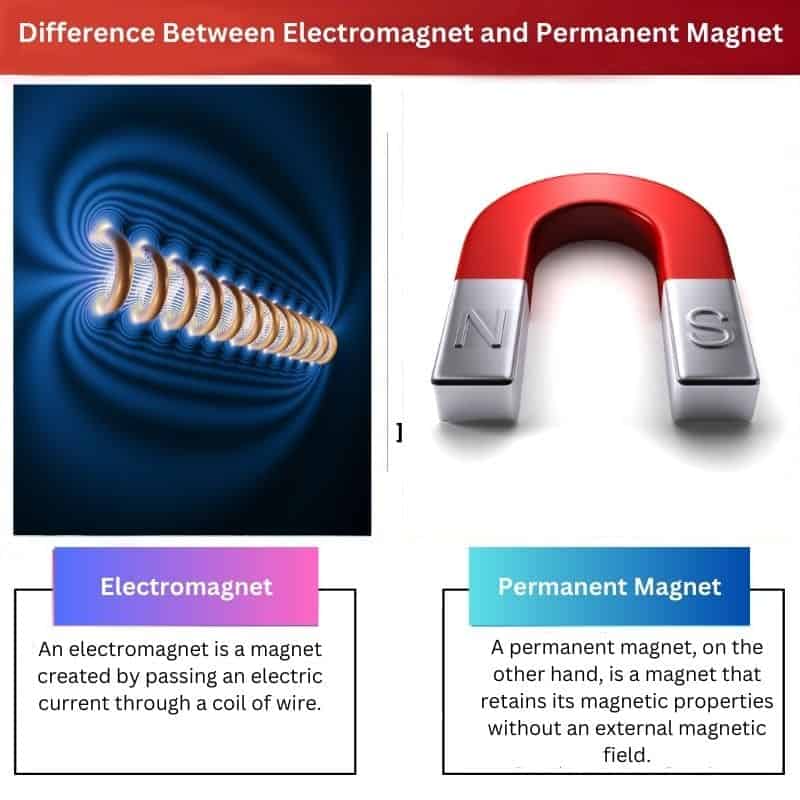Key Takeaways
- An electromagnet is a magnet created by passing an electric current through a coil of wire, generating a magnetic field.
- A permanent magnet, on the other hand, is a magnet that retains its magnetic properties without an external magnetic field.
- Electromagnets can be turned on and off by controlling the current flow, while permanent magnets are always “on.”

What is Electromagnet?
Electromagnet is a type of magnet in which a magnetic field is produced by using electricity or electric current. It works on a principle of Ampere’s Circuital Law which relates the magnetic fields around a closed loop to the electric current passing through it.
The relationship between electricity and magnetism was first discovered in the 19th century by Danish scientist and physicist Hans Christian Oersted. Later a British scientist named William Sturgeon created the first electromagnet by using copper wire.
Electromagnets can be easily made by wrapping an insulated wire into a coil around a soft iron core. The insulated wire used is made up of copper. As the electric current passes through it, coils behave like a magnet and produce a strong magnetic field around the wire. Magnetic fields are developed only when electric current flows through coils, as soon as the current flow is stopped, magnetic fields will come to an end. The strength of the magnetic field can be increased or decreased by increasing or decreasing the amount of electricity flowing through coils. The three types of electromagnets commonly used are Resistant, Superconductors, and hybrids.
Electromagnets are widely used in electrical devices such as transformers, motors, generators, electric bells, MRI machines, loudspeakers, hard disks, etc.

What is Permanent Magnet?
Permanent magnets are artificial magnets that can generate their magnetic field for a long period without any external sources like electromagnets. The most significant property of a magnet is that it can attract ferromagnetic material, i.e., material that contains some degree of iron and can be magnetized, such as iron, steel, nickel, cobalt, and their alloys.
Permanent magnets are produced by heating ferromagnetic material found in mineral rocks at extremely high temperatures while exposing it to the external magnetic field. Different types of permanent magnets can be produced by alternating the heating temperature. The most widely used permanent magnets are Ferrite, Alnico, Samarium Cobalt, and Neodymium magnets, also known as Neodymium Iron Boron (NdFeB), the strongest type of permanent magnet.
Permanent magnets play an important role in engineering and are widely used in equipment like headphones, loudspeakers, mobile phones, sensors, refrigerator magnets, hard disks, cars, etc. These magnets are also used in many hospital equipments like MRI scanners, scrape operations, compasses, toys, credit or debit cards, audio cassettes, electric guitars, etc.

Difference Between Electromagnet and Permanent Magnet
- Electromagnet needs electric current to generate magnetic fields, whereas permanent magnets do not need any external source, they create their magnetic field.
- Electromagnets are made up of soft materials like soft iron, whereas permanent magnets are made up of hard materials like steel.
- The strong magnetic field generated by electromagnets can be adjusted easily by altering the passing electric current, whereas the strength of the magnetic field generated by permanent magnets is fixed and cannot be changed.
- The polarity of electromagnets can be changed, whereas the polarity of permanent magnets can never be changed.
- Electromagnets can be demagnetized by withdrawing the electric current, whereas permanent magnets can never be demagnetized.
Comparison Between Electromagnet and Permanent Magnet
| Parameters of Comparison | Electromagnet | Permanent Magnet |
|---|---|---|
| Magnetization | They are temporary Magnetized | They are permanently Magnetized |
| Material | They are made up of soft materials | They are made up of hard materials |
| Strength | Strength of the magnetic field can be easily altered | Strength of the magnetic field is fixed |
| Polarity | Polarity of electromagnets can be changed | Polarity of permanent magnets can not change |
| Demagnetized | They can be demagnetized by stopping electric current flow | They cannot be demagnetized |

- https://ieeexplore.ieee.org/abstract/document/1608462
- https://iopscience.iop.org/article/10.1088/1361-6668/ab6fea/meta
